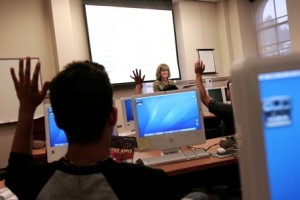 Christopher McNeill ’12 (Setauket, N.Y.) spends about 10 hours each week in the College’s Foreign Language and Literatures Resource Center.
Christopher McNeill ’12 (Setauket, N.Y.) spends about 10 hours each week in the College’s Foreign Language and Literatures Resource Center.
A double major in international affairs and German, McNeill uses the center to edit papers, practice German with interactive games, watch contemporary German DVDs and TV, and work on class projects, such as a radio program he designed in the style of one of the great German post-war writers. He also works as a proctor, helping other students.
“The technology, atmosphere, and assistance at the center has been an invaluable resource for me whether I’m helping elementary German students with labs and papers or putting together an iMovie project or recording,” McNeill says.
Located in Pardee Hall, the collaborative, high-tech facility was founded in 1990 to provide educational technology to help students learn and understand foreign languages and cultures.
The center houses two computer rooms (Mac and PC) and has an extensive collection of videos, audio CDs, DVDs, laser disks, and software language learning materials for Greek, Latin, French, German, Hebrew, Chinese, Japanese, Russian, and Spanish. Additionally, students can learn in technology-rich classrooms and can develop an ePortfolio, a digital archive that documents and showcases a student’s language achievements.
“There are so many opportunities in the center for students to use their second language-to watch TV, to Skype abroad, to talk with native speakers or other students who are studying the same language, and to get and give help. The center promotes a communicative approach to language,” says Mary Toulouse, director of the center.
The center serves as a workshop where numerous creative projects take shape. Elementary German students collaborated to write German fairy tales. Elementary French students remade parts of the film Le diner de Cons. Advanced German students used the CMap software tool to research final papers, documenting links to authentic sources, clips, and pictures to create multimedia research documents. Japanese students produced self-portraits.
Susan Grunewald ’11 (Wilton, Conn.), a Russian and East European studies major, uses the lab for her classes in German, French, and Russian. She says all the software options have made learning several different languages a lot easier and even fun.
“I enjoy being able to explore the creative side of language classes with software such as iMovie,” she says. “Making a movie tests all the grammar skills that I have learned in class in a fun way.”
The center regularly hosts professional development workshops, and it’s common to find faculty informally sharing ideas about what they are doing.
“As they see what students can do with technology, more and more professors are including multimedia assignments in their curriculum,” Toulouse says. “When I first came here six years ago, the resource center was used primarily for workbook assignments-listen and repeat; maybe two or three professors gave multimedia assignments. Now people regularly come into the resource center to teach. Moreover, instructors from every language are asking students to speak, interact, document, write, and create in a second language thanks to the technology and the setting.”
The center also presents art exhibits and programs to help foster appreciation of other cultures. Currently on display is Writing Against the War, an exhibit about German writer Ingeborg Bachmann, and the Tourees Francophone Film Festival will begin Oct. 6. The center is hosting more coffee/tea hours, in which students practice their language skills with each other in casual conversation over a hot beverage.
 Christopher McNeill ’12 (Setauket, N.Y.) spends about 10 hours each week in the College’s Foreign Language and Literatures Resource Center.
Christopher McNeill ’12 (Setauket, N.Y.) spends about 10 hours each week in the College’s Foreign Language and Literatures Resource Center.